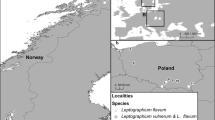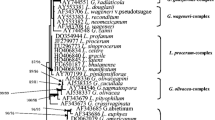Abstract
Species of Leptographium are generally characterized by mononematous conidiophores and are commonly associated with bark beetles and weevils. These species are responsible for sapstain and in some cases serious diseases on a range of primarily coniferous trees. In comparison with coniferous trees, the occurrence of Leptographium species on hardwood trees has been poorly studied in Europe. During a survey of ophiostomatoid fungi on various tree species in Norway and Poland, three unusual species, which fit the broader morphological description of Leptographium spp., were found in association with Scolytus ratzeburgi, Dryocoetes alni and Trypodendron domesticum on a variety of hardwoods, and from wounds on Tilia cordata. Phylogenetic analyses of sequence data for three gene regions (ITS2-LSU, β-tubulin, and TEF1-α) showed that these Leptographium species are phylogenetically closely related to each other and form a well-supported lineage that included Grosmannia grandifoliae and Leptographium pruni. The first species could be distinguished from the other Leptographium species based on conidiophores arising from spiral hyphae, chlamydospore-like structures and a hyalorhinocladiella-like synanamorph in culture. The second species differs from the previous one by having distinctly shorter conidiophores and smaller conidia. This species also produces a well-developed sporothrix-like synanamorph with denticulate conidiogenous cells. Based on these unusual morphological characteristics and distinct DNA sequences, these fungi were recognised as new taxa for which the names Leptographium trypodendri sp. nov. and L. betulae sp. nov. are provided. The third group of isolates belonged to Grosmannia grandifoliae, representing the first report of this species outside of the USA. The newly defined G. grandifoliae complex is the first species complex in Leptographium s.l. consisting of only hardwood-infecting species.






Similar content being viewed by others
References
Alamouti SM, Wang V, Di Guistini S, Six DL, Bohlmann J, Hamelin RC, Feau N, Breuil C (2011) Gene genealogies reveal cryptic species and host preferences for the pine fungal pathogen Grosmania clavigera. Mol Ecol 20:2581–2602. doi:10.1111/j.1365-294X.2011.05109.x
Cobb FW (1988) Leptographium wageneri, cause of black stain root disease; a review of its discovery, occurrence and biology with emphasis on pinyon and ponderosa pine. In: Harrington TC, Cobb FW (eds) Leptographium root disease in conifers. APS Press, St Paul, pp 41–62
Darriba D, Taboada GL, Doallo R, Posada D (2012) jModelTest 2: more models, new heuristics and parallel computing. Nat Methods 9(8):772. doi:10.1038/nmeth.2109
Davidson RW (1942) Some additional species of Ceratostomella in the United States. Mycologia 34:650–662
Davidson RW (1958) Additional species of Ophiostomataceae from Colorado. Mycologia 50:661–670
Davidson RW (1971) New species of Ceratocystis. Mycologia 63:5–15
Davidson RW (1976) Sapwood staining fungi from two tree species. Mem N. Y. Bot Gard 28:45–49
De Beer ZW, Wingfield MJ (2013) Emerging lineages in the Ophiostomatales. In: Seifert KA, De Beer ZW, Wingfield MJ (eds) The Ophiostomatoid fungi: expanding frontiers. CBS Biodiversity Series, The Netherlands
De Beer ZW, Seifert KA, Wingfield MJ (2013) A nomenclator for ophiostomatoid genera and species in the Ophiostomatales and Microascales. In: Seifert KA, De Beer ZW, Wingfield MJ (eds) The ophiostomatoid fungi: expanding frontiers. CBS Biodiversity Series, The Netherlands
De Errasti A, de Beer ZW, Coetzee MPA, Roux J, Rajchenberg M, Wingfield MJ (2016) Three new species of Ophiostomatales from Nothofagus in Patagonia. Mycol Prog 15:17. doi:10.1007/s11557-016-1158-z
Gebhardt H, Kirschner R, Oberwinkler F (2002) A new Ophiostoma species isolated from the ambrosia beetle Xyleborus dryographus (Coleoptera: Scolytidae). Mycol Prog 1:377–382. doi:10.1007/s11557-006-0034-7
Glass NL, Donaldson GC (1995) Development of primer sets designed for use with the PCR to amplify conserved genes from filamentous ascomycetes. Appl Environ Microbiol 61:1323–1330
Greif MD, Gibas CF, Currah RS (2006) Leptographium piriforme sp. nov., from a taxonomically diverse collection of arthropods collected in an aspen-dominated forest in western Canada. Mycologia 98:771–780. doi:10.3852/mycologia.98.5.771
Grobbelaar J, de Beer ZW, Bloomer P, Wingfield MJ, Wingfield BD (2010) Ophiostoma tsotsi sp. nov., a wound- infesting fungus of hardwood trees in Africa. Mycopathologia 169:413–423. doi:10.1007/s11046-009-9267-8
Guindon S, Gascuel O (2003) A simple, fast and accurate method to estimate large phylogenies by maximum-likelihood. Syst Biol 52:696–704. doi:10.1080/10635150390235520
Guindon S, Dufayard JF, Lefort V, Anisimova M, Hordijk W, Gascuel O (2010) New algorithms and methods to estimate maximum-likelihood phylogenies: assessing the performance of PhyML 3.0. Syst Biol 59:307–321. doi:10.1093/sysbio/syq010
Harrington TC (1988) Leptographium species, their distribution hosts and insect vectors. In: Harrington TC, Cobb FW Jr (eds) Leptographium root diseases on conifers. APS Press, St. Paul, pp 1–39
Harrington TC, Cobb FW (1987) Leprographium wageneri var. pseudotsugae var. nov. cause of black stain root disease on Douglas-fir. Mycotaxon 30:501–507
Hawksworth DL (2011) A new dawn for the naming of fungi: impacts of decisions made in Melbourne in July 2011 on the future publication and regulation of fungal names. MycoKeys 1:7–20. doi:10.3897/mycokeys.1.2062
Hicke JA, Logan JA, Powell J, Ojima DS (2006) Changing temperatures influence suitability for modeled mountain pine beetle (Dendroctonus ponderosae) outbreaks in the western United States. J Geophys Res 111:G02019. doi:10.1029/2005JG000101
Huang Y-T, Chi-Y Chen (2014) Leptographium globosum sp. nov., a new species with globose conidia. Mycol Prog 13:841–848. doi:10.1007/s11557-014-0967-1
Jacobs K, Wingfield MJ (2001) Leptographium species: tree pathogens, insect associates, and agents of blue-stain. The American Phytopathological Society Press, St. Paul
Jacobs K, Wingfield MJ, Crous PW, Harrington TC (1998) Leptographium engelmannii, a synonym of Leptographium abietinum, and description of Leptographium hughesii sp. nov. Can J Bot 76:1660–1667. doi:10.1139/cjb-76-9-1660
Jacobs K, Wingfield MJ, Roux J (1999) Leptographium eucalyptophilum, a new species from Eucalyptus in the Congo. S Afr J Bot 65:388–391
Jacobs K, Bergdahl DR, Wingfield MJ, Halik S, Seifert KA, Bright DE, Wingfield BD (2004) Leptographium wingfieldii introduced into North America and found associated with exotic Tomicus piniperda and native bark beetles. Mycol Res 108:411–418. doi:10.1017/S0953756204009748
Jacobs K, Eckhardt LG, Wingfield MJ (2006) Leptographium profanum sp. nov., a new species from hardwood roots in North America. Can J Bot 84:759–766. doi:10.1139/b036-030
Jacobs K, Krokene P, Solheim H, Wingfield MJ (2010) Two new species of Leptographium from Dryocetes authographus and Hylastes cunicularius in Norway. Mycol Prog 9:69–78
Jankowiak R (2012) Ophiostomatoid fungi associated with Ips sexdentatus on Pinus sylvestris in Poland. Dendrobiology 68:43–54
Jankowiak R, Bilański P (2013a) Association of the pine-infesting Pissodes species with ophiostomatoid fungi in Poland. Eur J For Res 132:523–534. doi:10.1007/s10342-013-0693-2
Jankowiak R, Bilański P (2013b) Diversity of ophiostomatoid fungi associated with the large pine weevil, Hylobius abietis and infested Scots pine seedlings in Poland. Ann For Sci 70:391–402
Jankowiak R, Bilański P (2013c) Ophiostomatoid fungi associated with root-feeding bark beetles in Poland. For Pathol 43:422–428. doi:10.1111/efp.12049
Katoh K, Standley DM (2013) MAFFT multiple sequence alignment software version 7: improvements in performance and usability. Mol Biol Evol 30:772–780. doi:10.1093/molbev/mst010
Kendrick WB (1962) The Leptographium complex Verticicladiella Hughes. Can J Bot 40:771–797
Kirisits T (2004) Fungal associates of European bark beetles with special emphasis on the ophiostomatoid fungi. In: Lieutier F, Day KR, Battisti A, Grégoire JC, Evans H (eds) Bark and wood boring insects in living trees in Europe, A Synthesis. Kluwer, Dordrecht, pp 185–223
Linnakoski R, De Beer ZW, Duong TA, Niemelä P, Pappinen A, Wingfield MJ (2012) Grosmannia and Leptographium spp. associated with conifer-infesting bark beetles in Finland and Russia including Leptographium taigense sp. nov. Antonie Van Leeuwenhoek 102:375–399. doi:10.1007/s10482-012-9747-6
Lu M, Zhou XD, de Beer ZW, Wingfield MJ, Sun JH (2009) Ophiostomatoid fungi associated with the invasive pine infesting bark beetle, Dendroctonus valens, in China. Fungal Divers 38:133–145
Lu M, Wingfield MJ, Gillette NE, Mori SR, Sun JH (2010) Complex interactions among host pines and fungi vectored by an invasive bark beetle. New Phytol 187:859–866. doi:10.1111/j1469-8137.2010.03316.x
Lu M, Wingfield MJ, Gillette NE, Sun JH (2011) Do novel genotypes drive the success of an invasive bark beetle-fungus complex? Implications for potential reinvasion. Ecology 92:2013–2019. doi:10.1890/11-0687.1
Malloch D, Blackwell M (1993) Dispersal biology of ophiostomatoid fungi. In: Wingfield MJ, Seifert KA, Webber JF (eds) Ceratocystis and Ophiostoma: taxonomy, ecology, and pathology. APS Press, St. Paul, pp 195–206
Masuya H, Wingfield MJ, Kubono T, Ichihara Y (2004) Leptographium pruni, sp. nov. from bark beetle-infested Prunus jamasakura in Japan. Mycologia 96:548–557. doi:10.2307/3762174
Musvuugwa T, de Beer ZW, Duong TA, Dreyer LL, Oberlander KC, Roets F (2015) New species of Ophiostomatales from Scolytinae and Platypodinae beetles in the Cape Floristic Region, including the discovery of the sexual state of Raffaelea. A van Leeuw J Microb 108:933–950. doi:10.1007/s10482-015-0547-7
O’Donnell K, Cigelnik E (1997) Two divergent intragenomic rDNA ITS2 types within a monophyletic lineage of the fungus Fusarium are nonorthologous. Mol Phylogent Evol 7:103–116. doi:10.1006/mpev.1996.0376
Paciura D, de Beer ZW, Jacobs K, Zhou XD, Ye H, Wingfield MJ (2010) Eight new Leptographium species associated with tree-infesting bark beetles in China. Persoonia 25:94–108. doi:10.3767/003158510X551097
Rambaut A, Drummond AJ (2007) Tracer v1.4 http://beast.bio.ed.ac.uk/Tracer)
Robert V, Vu D, Amor AB et al (2013) MycoBank gearing up for new horizons. IMAFungus 4:371–379. doi:10.5598/imafungus.2013.04.02.16
Ronquist F, Huelsenbeck JP (2003) MrBayes 3: Bayesian phylogenetic inference under mixed models. Bioinformatics 19:1572–1574. doi:10.1093/bioinformatics/btg180
Six DL, Wingfield MJ (2011) The role of phytopathogenicity in bark beetle-fungus symbioses: a challenge to the classic paradigm. Annu Rev Entomol 56:255–272. doi:10.1146/annurev-ent-120709-144839
Solheim H, Krokene P (1998) Growth and virulence of mountain pine beetle associated blue-stain fungi, Ophiostoma clavigerum and Ophiostoma montium. Can J Bot 76:561–566
Taerum SJ, Hoareau TB, Duong TA, de Beer ZW, Jankowiak R, Wingfield MJ (2017) Putative origins of the fungus Leptographium procerum. Fungal Biol 121:82–94. doi:10.1016/j.funbio.2016.09.007
Tamura K, Stecher G, Peterson D, Filipski A, Kumar S (2013) MEGA6: molecular evolutionary genetics analysis version 6.0. Mol Biol Evol 30:2725–2729. doi:10.1093/molbev/mst197
Wainhouse D, Murphy S, Greig B, Webber J, Vielle M (1998) The role of the bark beetle Cryphalus trypanus in the transmission of the vascular wilt pathogen of takamaka (Calophyllum inophyllum) in the Seychelles. For Ecol Manag 108:193–199. doi:10.1016/S0378-1127(98)00234-5
Webber JF, Jacobs K, Wingfield MJ (1999) A re-examination of the vascular wilt pathogen of takamaka (Calophyllum inophyllum). Mycol Res 103:1588–1592. doi:10.1017/S0953756299001021
White TJ, Bruns T, Lee S, Taylor J (1990) Amplification and direct sequencing of fungal ribosomal RNA genes for phylogenetics. In: Innis MA, Gelfand DH, Sninsky JJ, White TJ (eds) PCR protocols: a guide to methods and applications. Academic Press, San Diego, pp 315–322
Wiehe PO (1949) Wilt of Calophyllum inophyllum L. var. tacamaha (Willd.) R.E.V. caused by Haplographium calophylli sp. nov. in Mauritius. Mycol Pap 29:1–12
Wingfield MJ, Garnas JR, Hajek A, Hurley BP, de Beer ZW, Taerum SJ (2016) Novel and co-evolved associations between insects and microorganisms as drivers of forest pestilence. Biol Invasions 18:1045–1056. doi:10.1007//s10530-016-1084-7
Yin M, Duong TA, Wingfield MJ, Zhou XD, De Beer ZW (2015) Taxonomy and phylogeny of the Leptographium procerum complex, including L. sinense sp. nov. and L. longiconidiophorum sp. nov. Antonie Van Leeuwenhoek 107:547–563. doi:10.1007/s10482-014-0351-9
Zipfel RD, De Beer ZW, Jacobs K, Wingfield BD, Wingfield MJ (2006) Multi-gene phylogenies define Ceratocystiopsis and Grosmannia distinct from Ophiostoma. Stud Mycol 55:75–97. doi:10.3114/sim.55.1.133
Acknowledgements
This work was supported by the National Science Centre, Poland (contract No. UMO-2014/15/B/NZ9/00560). The work in Norway is partly financed by Norwegian biodiversity information centre and is part of a Master thesis for T.A.
Conflict of interest
The authors declare that have no conflict of interest.
Author information
Authors and Affiliations
Corresponding author
Rights and permissions
About this article
Cite this article
Jankowiak, R., Strzałka, B., Bilański, P. et al. Two new Leptographium spp. reveal an emerging complex of hardwood-infecting species in the Ophiostomatales. Antonie van Leeuwenhoek 110, 1537–1553 (2017). https://doi.org/10.1007/s10482-017-0905-8
Received:
Accepted:
Published:
Issue Date:
DOI: https://doi.org/10.1007/s10482-017-0905-8




